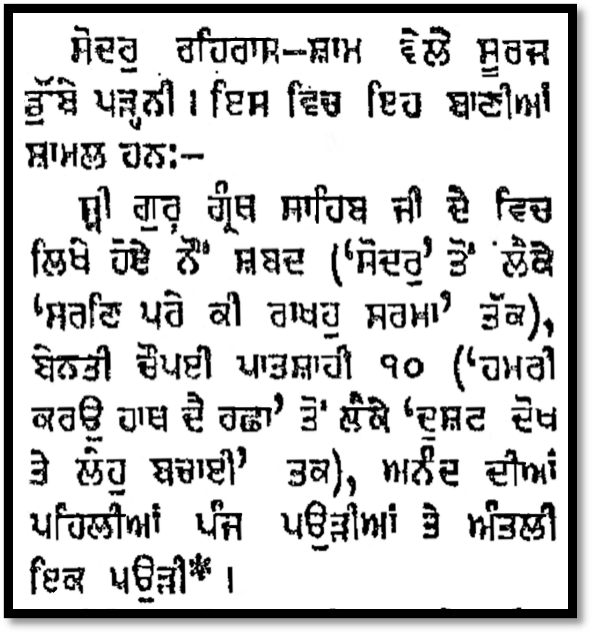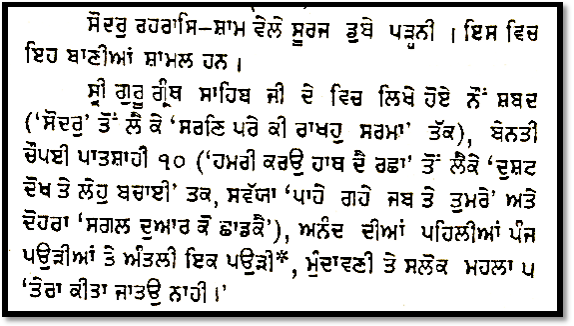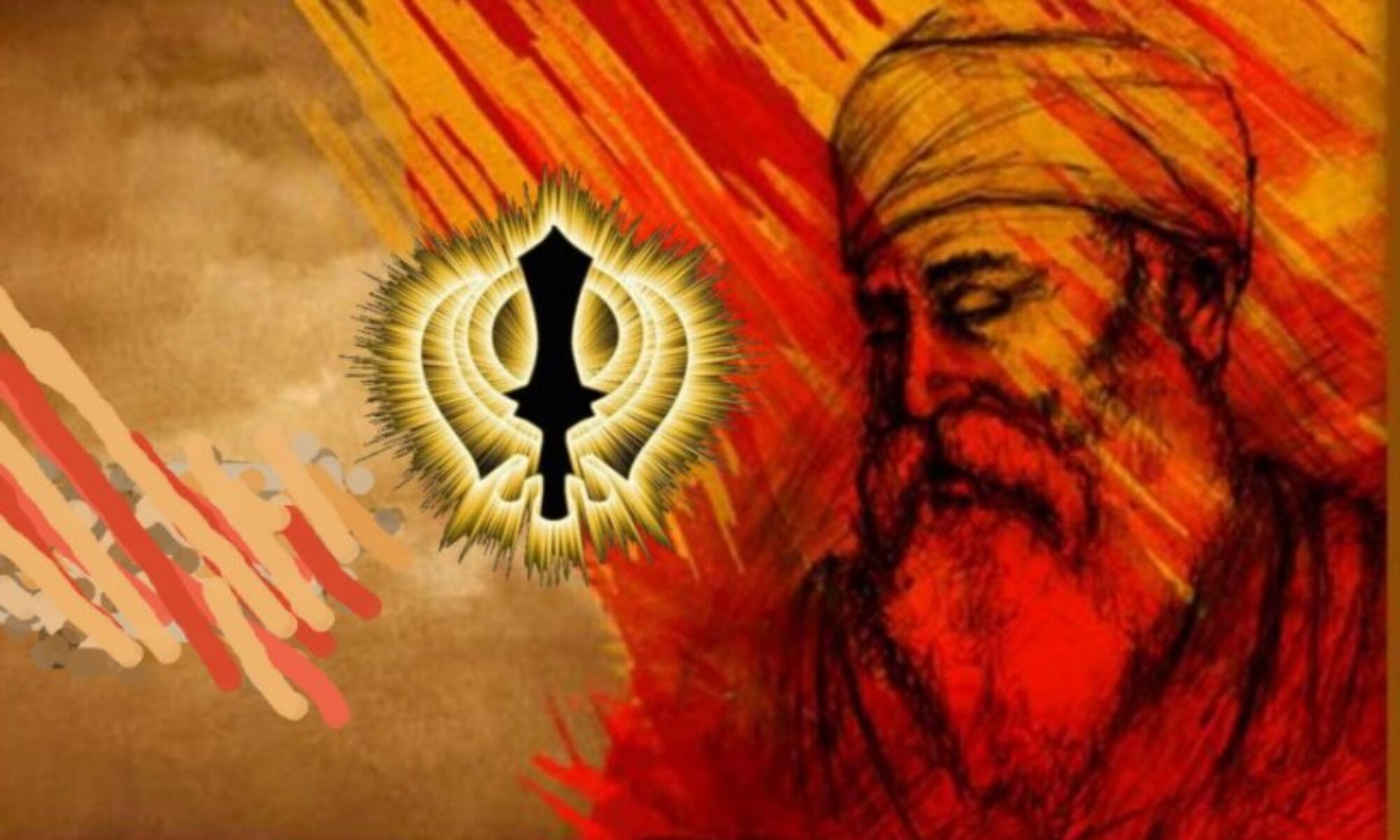Research by Bhai Manvir Singh UK
This article shares the research of Bhai Manvir Singh UK on the topic of Rehraas Sahib, the Sikh evening prayer. Bhai Manvir Singh UK spent 10 years writing the book ‘Sikh Rehat Maryada: History, Guiding Principles and a Contextual Translation’. The first initial project of researching and delving in the Sikh Rehat Maryada dates back to 2010. Bhai Manvir Singh’s research is a great resource for helping Sikhs of today understand the details of the Sikh Rehat Maryada document which has been observed and used as an official reference point by Sri Akal Takhat Sahib and Panthic institutions for over 80 years.
To illustrate the Sikh tradition of reading the evening prayer of Rehraas Sahib, Bhai Manvir Singh Khalsa provides the following scriptural quotations (p. 40-41):
ਏਹਾ ਸੰਧਿਆ ਪਰਵਾਣੁ ਹੈ ਜਿਤੁ ਹਰਿ ਪ੍ਰਭੁ ਮੇਰਾ ਚਿਤਿ ਆਵੈ ॥
“That evening prayer alone is acceptable, which brings the Lord-God to my consciousness.”
(Raag Bihaagra M:3, Ang 553)
ਸੰਝੈ ਸੋਦਰੁ ਗਾਵਣਾ ਮਨ ਮੇਲੀ ਕਰਿ ਮੇਲਿ ਮਿਲੰਦੇ ॥
“They (the Gursikhs) recite and sing the prayer of ‘Sodar’ in the evening, and heartily associate with like-minded (Guru-loving) individuals.”
(Bhai Gurdas Ji: Vaar 6, Pauri 3)
ਸੰਧਿਆ ਸਮੇਂ ਸੁਨੈ ਰਹਿਰਾਸ । ਕੀਰਤਨ ਕਥਾ ਸੁਨੈ ਹਰਿ ਜਾਸ ।
ਇਨ ਪੈ ਨੇਮ ਜੁ ਏਕ ਕਰਾਇ । ਸੋ ਸਿਖ ਅਮਰਪੁਰੀ ਮਹਿ ਜਾਇ ।੩।
“In the evening listen to Rehraas; and pay attention to Kirtan (the singing of Gurbani) and Katha (sermon). One who practices such a routine, will attain the eternal bliss. |3|”
(Rehatnama: Bhai Nand Lal Singh Ji, p. 55)
ਜਬ ਜਾਨੈ ਰਾਤਿ ਦੁਇ ਘੜੀਆਂ ਦਿਨ ਰਹਿਆ ਹੈ, ਤਾਂ ਸੋਦਰੁ ਰਹਿਰਾਸ ਨਾਲ ਪੜ੍ਹੈ ।
“When you know there are 6 hours (2 ‘GhareeaaN’) left of the day, then read Sodar Rehraas.”
(Prem Sumarg – p. 119)
Bhai Manvir Singh Khalsa writes (p. 41):
“The language and essence of the Shabads of Sodar Rehraas, also known as Rehraas Sahib, are so clear, easy, and full of meaning that it can easily be understood by a person tired after a day’s hard work to obtain adequate spiritual benefit. The simplicity of the prayer theme enables a person to concentrate their mind easily.”
It is apparent that there are different versions of Rehraas Sahib within the Sikh community. There is observable in Gurdwaras, Gutka Sahibs, videos and audio recordings. This can someone lead someone who is just beginning their Sikhi journey to feel confused. Bhai Manvir Singh Khalsa explains the diversity in the recitals and printed versions of Rehraas Sahib (p. 41):
There are many variations of Rehraas Sahib that are in existence, for example the Rehraas Sahib observed by Buddha Dal, Sri Akal Takhat Sahib, Takhat Sri Hazoor Sahib, Nanaksar, Jatha Bhindran – Mehta, Jatha Bhindran – Bhindar Kalan, Guru Nanak Nishkam Sewak Jatha, Rampur Khera, Samparda Baba Harbans Singh Delhi (Kaar Seva), and Sikh Dharma International (3HO). Variations occur in the beginning Shabads of Rehraas Sahib, before and after Chaupai Sahib, and the ending of Rehraas Sahib. Many of those whom read the different versions of Rehraas Sahib claim that their version is the version read and passed down by Guru Gobind Singh Ji. The problem that one is faced with is if Sikhs from differing viewpoints on Rehraas Sahib come together to do the evening prayer of Rehraas Sahib then which Rehraas Sahib should be recited.
It is said that there was a time when everyone read the same Rehraas Sahib. Overtime Gursikhs attached extra Shabads as part of their own Abhiaas (spiritual practice). If these Gursikhs were prominent, then when they passed away, their followers made their routine an inadvertent Maryada (tradition). In the early 20th century, the Panth came together on what is the basic Rehraas Sahib for the Panth, which would bring commonality and uniformity when reading Rehraas Sahib in the Sangat or in a Gurdwara.
Bhai Manvir Singh then goes on to explain the evolvement of the length and composition of Rehraas Sahib stated in the Sikh Rehat Maryada document. He first shares information on the 1936 version of the Sikh Rehat Maryada document writes (p. 42):
In the first draft of Sikh Rehat Maryada document, the ending of Sodar Rehraas was missing Mundaavani and Salok. This was rectified in the next draft.

1936 edition Sikh Rehat Maryada document, taken from www.Punjabdigilib.org
Translation:
Sodar Rehraas – in the evening after sunset. It compromises of the following Banis:
Nine Shabads (sacred hymns) of Sri Guru Granth Sahib Ji after Japji Sahib (from ‘so dru’ (‘so dar’) to the line ‘ਸਰਣਿ ਪਰੇ ਕੀ ਰਾਖਹੁ ਸਰਮਾ’ (‘sharan pare kee raakhu sarmaa’)), Benti Chaupai of the Tenth Guru (beginning ‘ਹਮਰੀ ਕਰੋ ਹਾਥ ਦੈ ਰੱਛਾ’ (‘hamree karo haath dai rachhaa’) and ending with ‘ਦੁਸਟ ਦੋਖ ਤੇ ਲੇਹੁ ਬਚਾਈ’ (‘dusht dokh te lehu bachaaee’)), Svaiyye (beginning with the words ‘ਪਾਂਇ ਗਹੇ ਜਬ ਤੇ ਤੁਮਰੇ’ (‘paaNe gehe jab te tumre’) and Dohra (beginning with the words ‘ਸਗਲ ਦੁਆਰ ਕਉ ਛਾਡਿ ਕੈ’ (‘sagal duaar kau chhaad kai’)), the first five pauris (stanzas) and last pauri (stanza) of Anand Sahib.
Bhai Manvir Singh then shares information on the 1946 amended Sikh Rehat Maryada document (p. 42):

1950 edition Sikh Rehat Maryada, taken from www.Punjabdigilib.org
Translation:
Sodar Rehraas – in the evening after sunset. It compromises of the following Banis:
Nine Shabads (sacred hymns) of Sri Guru Granth Sahib Ji after Japji Sahib (from ‘so dru’ (‘so dar’) to the line ‘ਸਰਣਿ ਪਰੇ ਕੀ ਰਾਖਹੁ ਸਰਮਾ’ (‘sharan pare kee raakhu sarmaa’)), Benti Chaupai of the Tenth Guru (beginning ‘ਹਮਰੀ ਕਰੋ ਹਾਥ ਦੈ ਰੱਛਾ’ (‘hamree karo haath dai rachhaa’) and ending with ‘ਦੁਸਟ ਦੋਖ ਤੇ ਲੇਹੁ ਬਚਾਈ’ (‘dusht dokh te lehu bachaaee’)), Svaiyye (beginning with the words ‘ਪਾਂਇ ਗਹੇ ਜਬ ਤੇ ਤੁਮਰੇ’ (‘paaNe gehe jab te tumre’) and Dohra (beginning with the words ‘ਸਗਲ ਦੁਆਰ ਕਉ ਛਾਡਿ ਕੈ’ (‘sagal duaar kau chhaad kai’)), the first five pauris (stanzas), the last pauri (stanza) of Anand Sahib, Mundaavani and the Salok Mahalla 5 beginning ‘ਤੇਰਾ ਕੀਤਾ ਜਾਤੋ ਨਾਹੀ’ (‘tera keeta jaato naahee’).
Commenting on Shabads recited before Rehraas Sahib, Bhai Manvir Singh writes (p. 43-44):
It is acceptable and a traditional to recite Shabads before and after as part of the recitation. Traditionally the Shabads beginning ‘ਹਰਿ ਜੁਗੁ ਜੁਗੁ ਭਗਤ ਉਪਾਇਆ…’ (“har jug jug bhagat upaayaa…”) followed by ‘ਦੁਖੁ ਦਾਰੂ ਸੁਖੁ ਰੋਗੁ ਭਇਆ’ (“dukh daaroo sukh rog bheyaa…”) are read at the start of Rehraas Sahib to give time for the Sangat to settle and concentrate their minds before Rehraas Sahib commences. This practice is followed at Sri Akal Takhat Sahib, Sri Harmandir Sahib (Amritsar), and many other Gurdwaras across the world. Traditionally, Shabads of Benti or supplication are read after Rehraas Sahib starting: ‘ਪਉੜੀ ॥ ਤਿਥੈ ਤੂ ਸਮਰਥੁ ਜਿਥੈ ਕੋਇ ਨਾਹਿ ॥…’ (“pauree. tithhai too samrathh, jithhe koe naahi…”).
In promoting a culture of respect and understanding of the minor differences between Sikhs in regards to some traditions and observances of religious discipline, Bhai Manvir Singh writes (p. 44):
For Panthic unity, the Panth accepted Rehraas Sahib should be respected. To claim that a particular longer version of Rehraas Sahib is the only acceptable or correct version, considering there are so many variations which vary in length, is harmful to Panthic unity.
Source for article:
Bhai Manvir Singh (2020). The Sikh Rehat Maryada: History, Guiding Principles & a Contextual Translation. UK: Namastwang Publishers. ISBN 1912232006. Available at www.KhalsaShop.com
